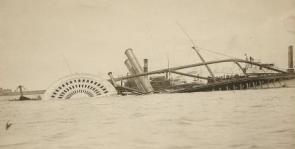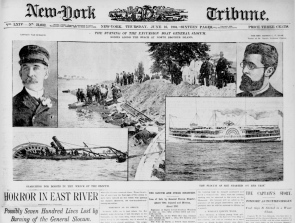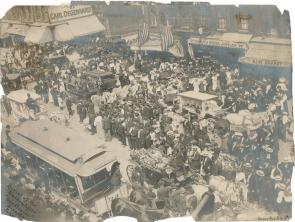The General Slocum Fire: On This Day, June 15
Posted by Anna Khomina on Wednesday, 06/15/2016
Today marks 112 years since the sinking of the General Slocum, the worst maritime disaster in New York City history.
 The General Slocum, named after a Civil War general, Henry Warner Slocum, was built in 1891. On June 15, 1904, St. Mark’s Evangelical Lutheran Church—a German American church on the Lower East Side—chartered the steamer for an annual picnic outing on Long Island to celebrate the end of Sunday school for the year. It was one of the congregation’s most beloved and popular events, and the vessel was filled with more than 1,300 passengers, mainly women and children excited for the day ahead. Soon after the Slocum left the pier at East Third Street, a small fire broke out and spread quickly.
The General Slocum, named after a Civil War general, Henry Warner Slocum, was built in 1891. On June 15, 1904, St. Mark’s Evangelical Lutheran Church—a German American church on the Lower East Side—chartered the steamer for an annual picnic outing on Long Island to celebrate the end of Sunday school for the year. It was one of the congregation’s most beloved and popular events, and the vessel was filled with more than 1,300 passengers, mainly women and children excited for the day ahead. Soon after the Slocum left the pier at East Third Street, a small fire broke out and spread quickly.
Many factors worked together to make the disaster more deadly. As the ship burned, Captain William H. Van Schaick did not head toward the closest shore, but instead headed to an island, fanning the flames as he increased speed.  Most of the passengers, like many Americans, did not know how to swim, and those who jumped off the ship were weighed down by their heavy clothing. The ship’s life vests, meanwhile, were made of rotted cork that quickly disintegrated in the water, and the life boats were found to be immovable. The ship did not hold regular fire drills, and the crew was woefully unprepared for such an emergency. In the end, approximately 1,021 passengers and crew members perished, leaving only 321 survivors.
Most of the passengers, like many Americans, did not know how to swim, and those who jumped off the ship were weighed down by their heavy clothing. The ship’s life vests, meanwhile, were made of rotted cork that quickly disintegrated in the water, and the life boats were found to be immovable. The ship did not hold regular fire drills, and the crew was woefully unprepared for such an emergency. In the end, approximately 1,021 passengers and crew members perished, leaving only 321 survivors.
The disaster made front-page news all over the country. Newspapers such as the New York Times printed long and detailed accounts of the fire and its aftermath, including rescue efforts by onlookers, policemen, and even the nurses and patients of North Brother Island’s hospital. The front page of the June 16, 1904, edition of the New York Tribune at right shows photographs of (clockwise from top right) the pastor of the Lutheran church, the Rev. George C.F. Haas, who lost his wife and daughter; the ship before and after it sank; Captain Van Schaick; and the scene at North Brother Island, where victim’s bodies washed ashore.
In the ensuing trial, eyewitnesses and survivors testified against Captain Van Schaick, crew members, the Knickerbocker Steamboat Company, and the company’s director, Frank Barnaby. All were acquitted but the captain, who was found guilty of criminal negligence and sentenced to ten years in prison. Van Schaick was eventually pardoned and released halfway through his sentence by President Taft.
The General Slocum disaster took an enormous, irreparable toll on the German American community of the Lower East Side, which had  already been slowly migrating uptown to the Upper East Side of Manhattan. The loss of so many family members, neighbors, and friends struck the community at its heart, and created a final incentive for many to leave.
already been slowly migrating uptown to the Upper East Side of Manhattan. The loss of so many family members, neighbors, and friends struck the community at its heart, and created a final incentive for many to leave.
Soon after the fire, President Roosevelt named a commission to investigate the disaster. A re-inspection of all steamers revealed the slipshod nature of the work of the US Steamboat Inspection Service. The commission recommended major reforms in the USSIS as well as in shipbuilding, fire prevention and containment, and crew training.